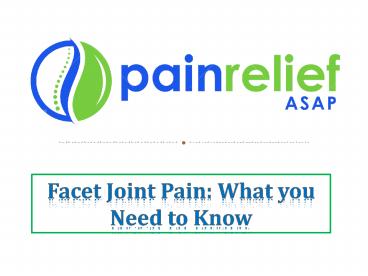Facet Joint Pain: What you Need to Know - PowerPoint PPT Presentation
Title:
Facet Joint Pain: What you Need to Know
Description:
Lower back pain (LBP) is relatively common among adults. As per some studies, approximately half of all adults may have some kind of back pain during the year. In about one-fifth of adults, lower back pain is chronic. According to various estimates, 15-45% of all lower back pains are facet joint pains. Since there could be so many causes of back pains, identifying the cause may be challenging [1]. – PowerPoint PPT presentation
Number of Views:8
Title: Facet Joint Pain: What you Need to Know
1
Facet Joint Pain What you Need to Know
2
Lower back pain (LBP) is relatively common among
adults. As per some studies, approximately half
of all adults may have some kind of back pain
during the year. In about one-fifth of adults,
lower back pain is chronic. According to various
estimates, 15-45 of all lower back pains are
facet joint pains. Since there could be so many
causes of back pains, identifying the cause may
be challenging 1. Some of the most common
causes of LBP are strains and sprain,
degeneration of spinal joints, and inflammatory
diseases like ankylosing spondylitis. Facet joint
pain belongs to degenerative diseases. It is
osteoarthritis of the lower back. Wear and tear
in the facet joint of the spine causes local
inflammation, muscle spasm, and irritation of
nearby nerves. Thus, pain often radiates to the
lower legs in most people.
3
Facet joint pain
It is a pain that emerges from a facet joint.
Usually, degenerative changes in the joint result
in local inflammation. It is a wear and tear
disease and thus more common among middle-aged
and older adults. It can be compared to
osteoarthritis of the knee. A condition that
makes movement difficult, and pain increases
while moving.
4
As the condition gets worse, inflammation may
spread to the surrounding soft tissues. As a
result, it causes spasms of surrounding muscles,
further limiting the range of motion.
Additionally, it may also irritate the sensory
nerve of these joints, a medial branch of the
sensory nerve. Irritation of this sensory nerve
explains why the pain radiates in many cases (see
Figure 2) 1. In facet joint pain, the
condition is made worse by physical exertion,
prolonged standing, and sitting. Since there is
inflammation, resting would not relieve pain.
However, one would feel that the pain is higher
in specific postures and reduced in others.
Usually, leaning backward would increase stress
on the joint and thus causing tremendous pain. On
the other hand, leaning forward would relieve the
pressure on the facet joint, thus bringing some
relief 2, 3.
5
Diagnosis of facet joint pain One can diagnose
the condition based on the symptoms. Location of
the pain, made worse by standing in specific
postures and relieved on bending forward, may
indicate the condition. Since there is local
inflammation, pain may occur on applying pressure
at specific parts of the spine. However, the
disease is best diagnosed by a qualified medical
professional, as there are numerous causes of
LBP. Generally, a doctor would ask for imaging
using an x-ray or MRI. However, MRI is preferred
these days as it is more sensitive. As in the
early stages of spinal diseases, changes are not
visible in the x-ray. A doctor would also carry
out lab tests to exclude other conditions like
rheumatoid arthritis, axial spondylitis, and so
on. Unlike other causes of back pain, doctors
often use the so-called facet joint injection to
confirm the diagnosis. It is a procedure in which
corticosteroids or anesthetics are injected into
the facet joint. This would provide significant
relief within 20-30 minutes. Such a kind of quick
pain relief will not occur in other common
inflammatory back conditions.
6
Treatment options for facet joint pain In most
back pains, and not just in facet joint pain, a
person may benefit significantly by altering the
lifestyle, improving posture, reducing stress on
the spine. It may mean changing the way a person
sits, altering sleeping habits. In addition,
losing body weight can help as it is a disease of
wear and tear. In most back pains, physical
therapy may help. Generally, a specialist would
advise on certain types of exercises. Stretching
exercises may help relieve pain. Strengthening of
back muscles may help prevent future episodes of
pain. In milder painful episodes, one may use
over-the-counter pain killers. For example,
ibuprofen would generally be more effective than
acetaminophen. In more severe cases, doctors
would prescribe non-steroidal anti-inflammatory
drugs along with muscle relaxants.
7
Visit Now
Pain Relief ASAP
Thank You































